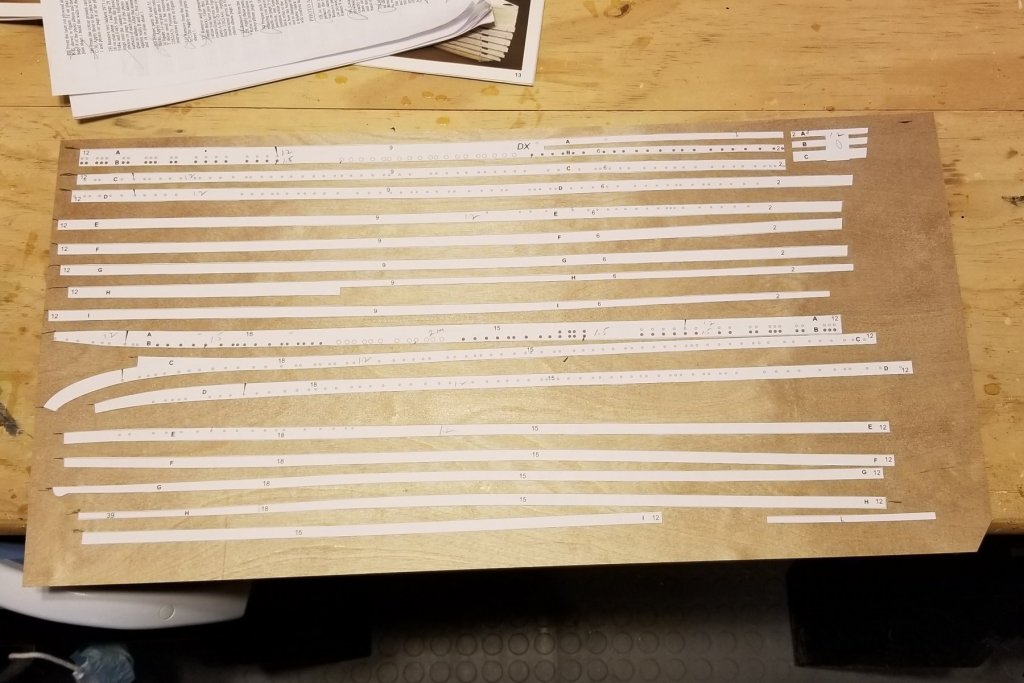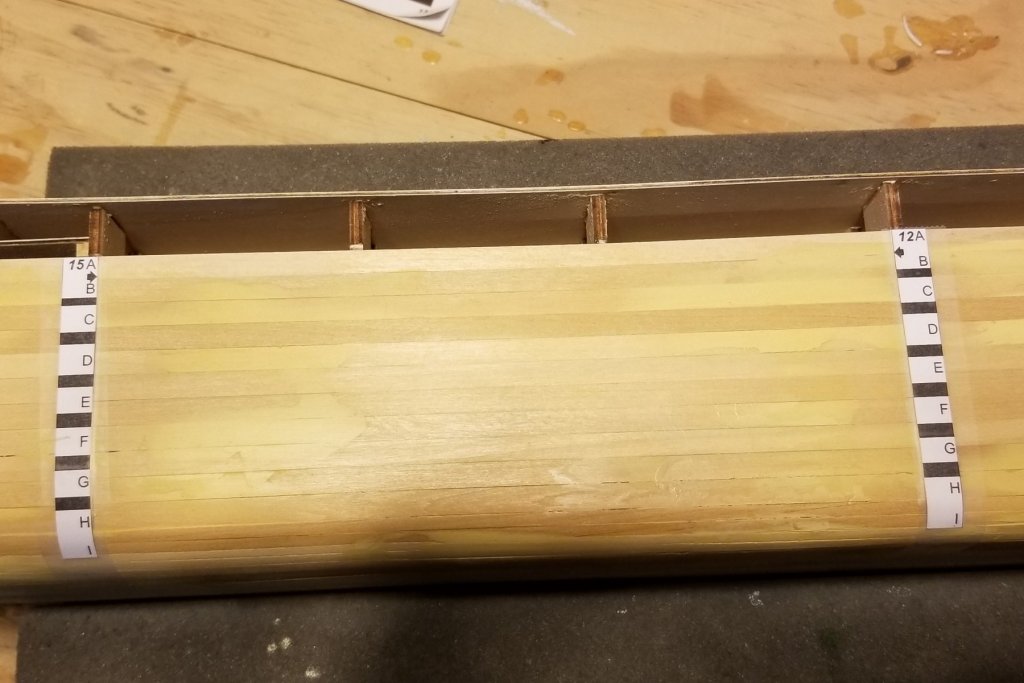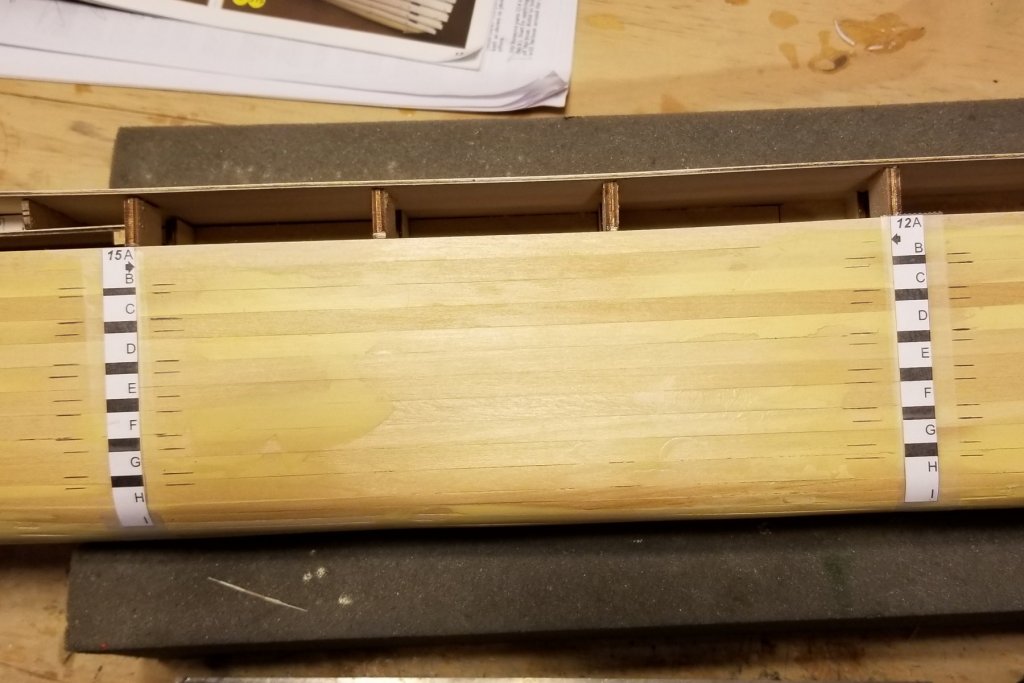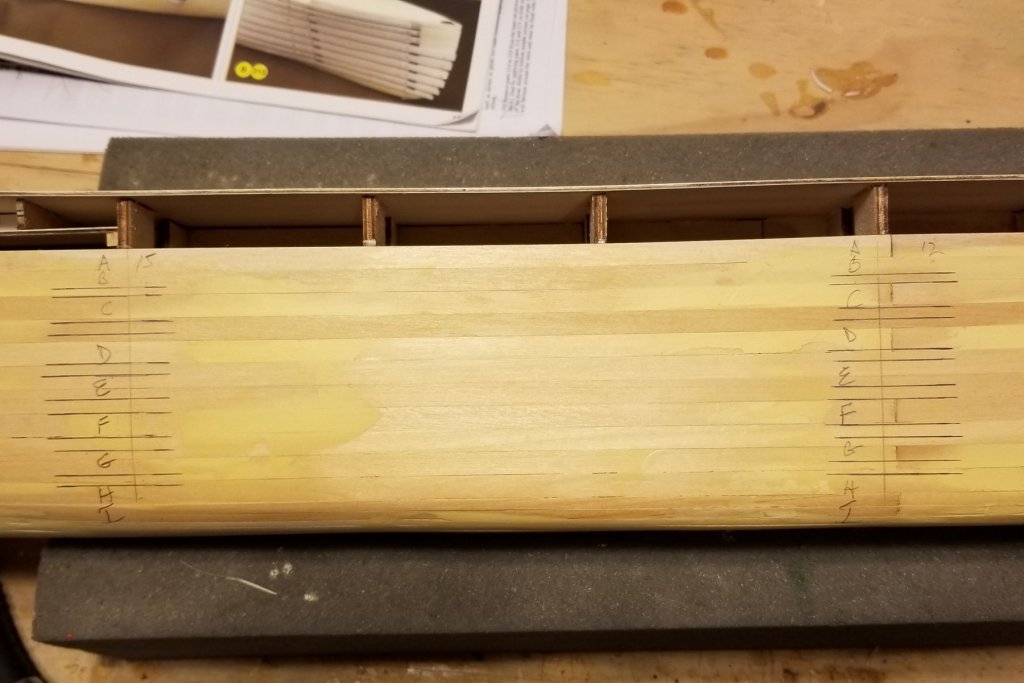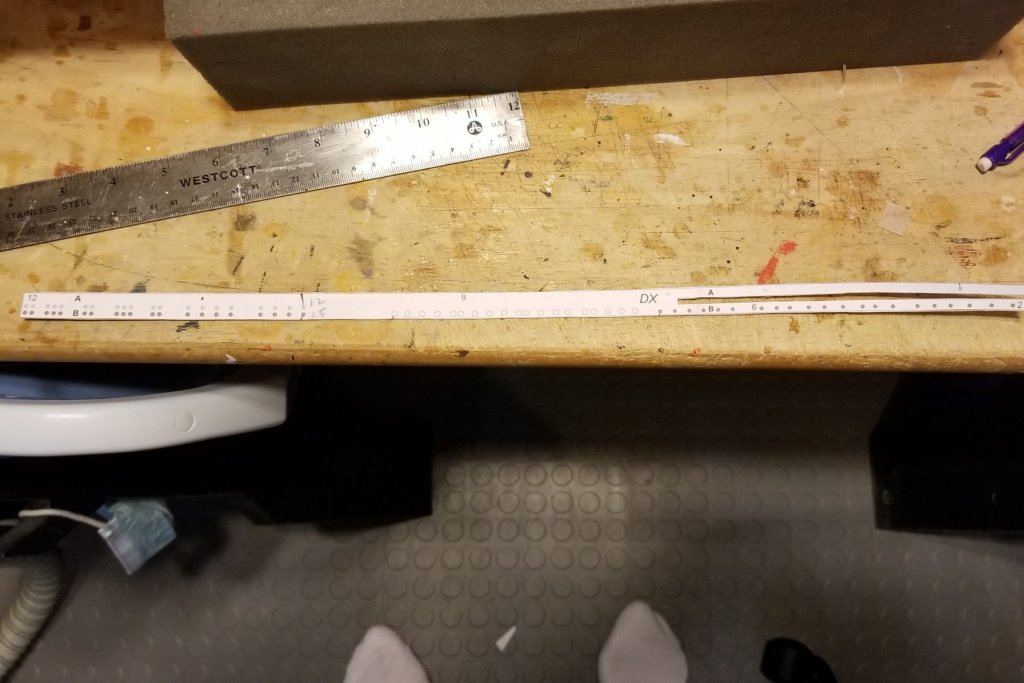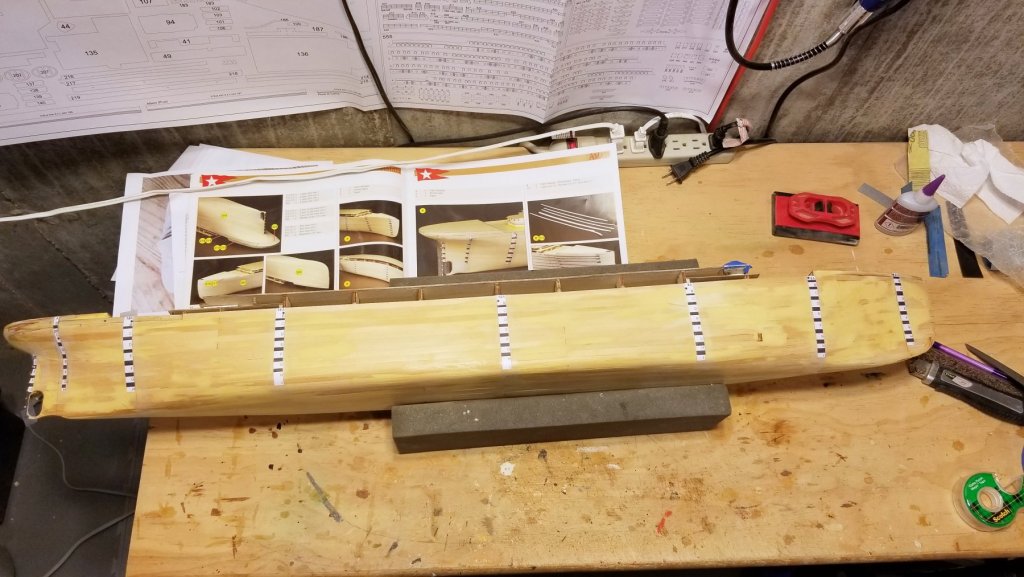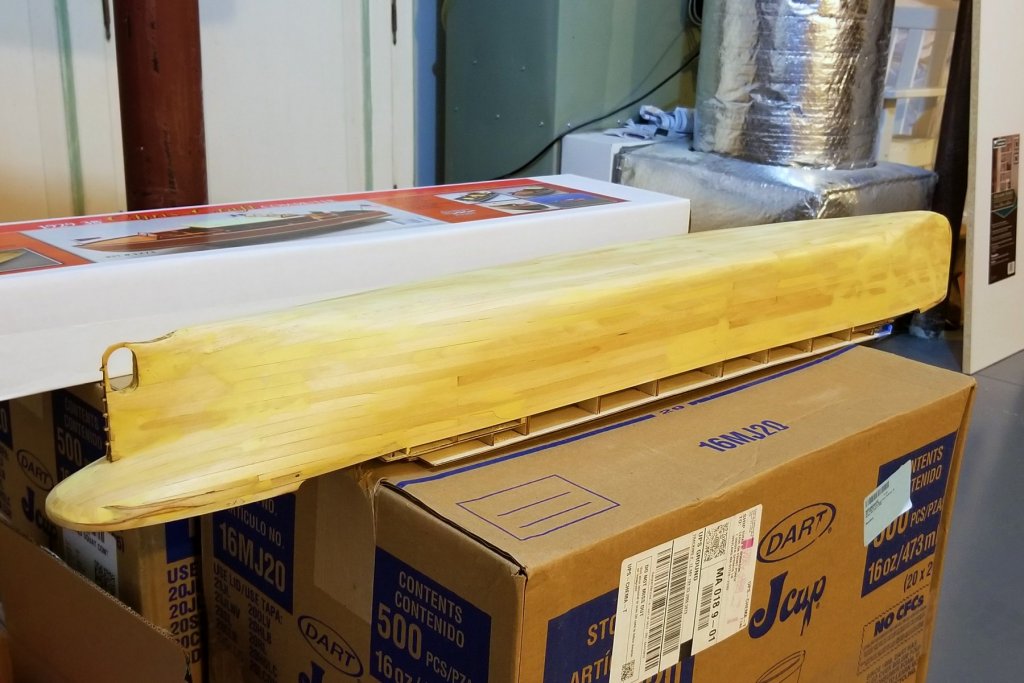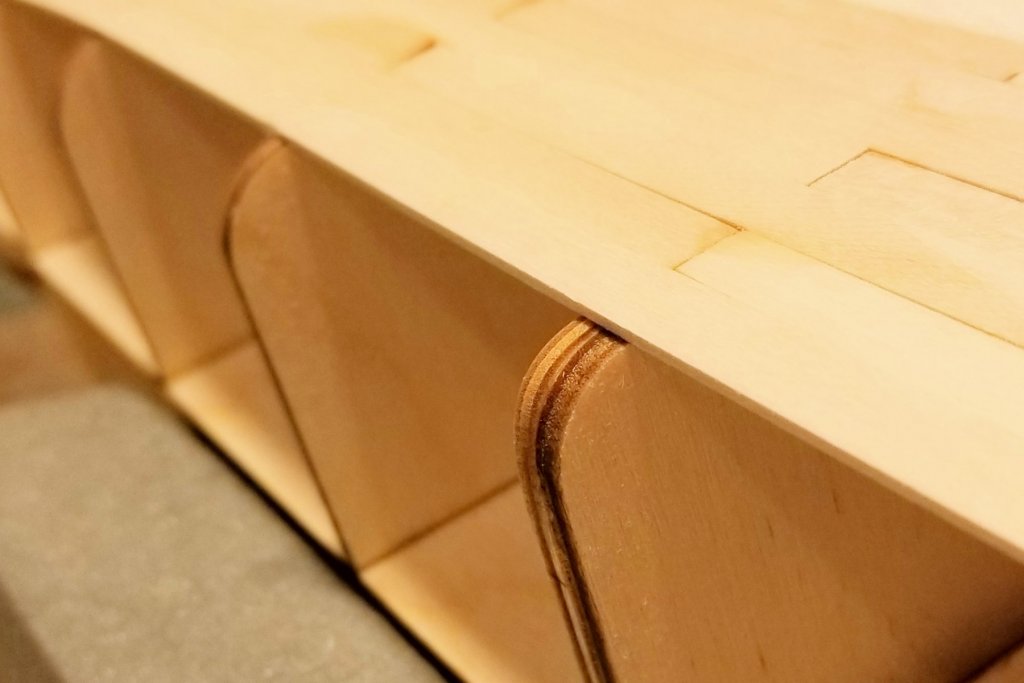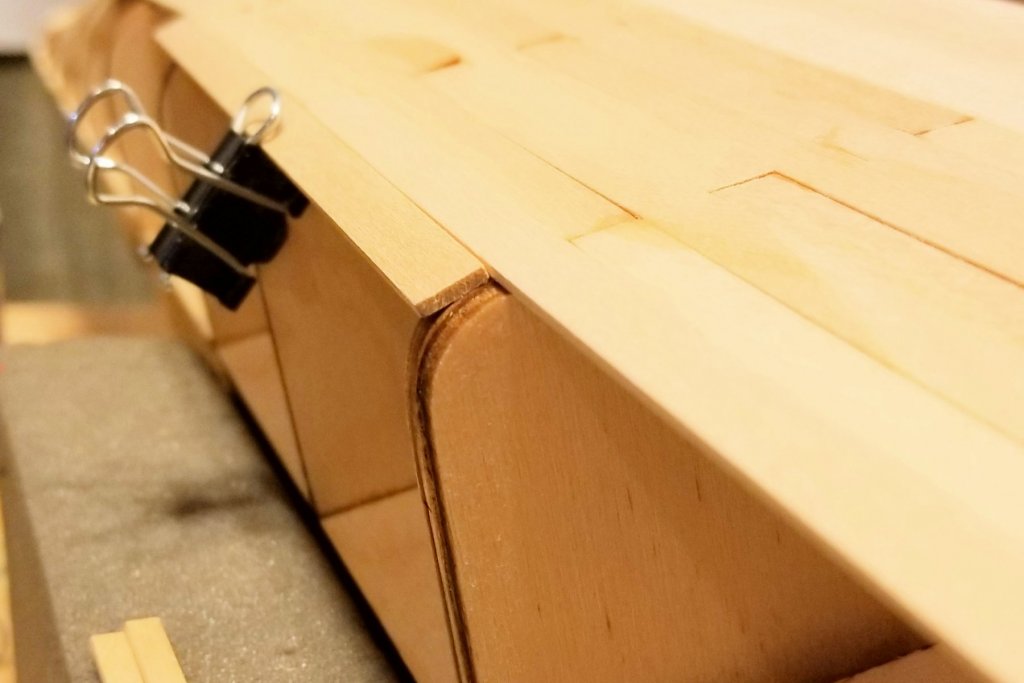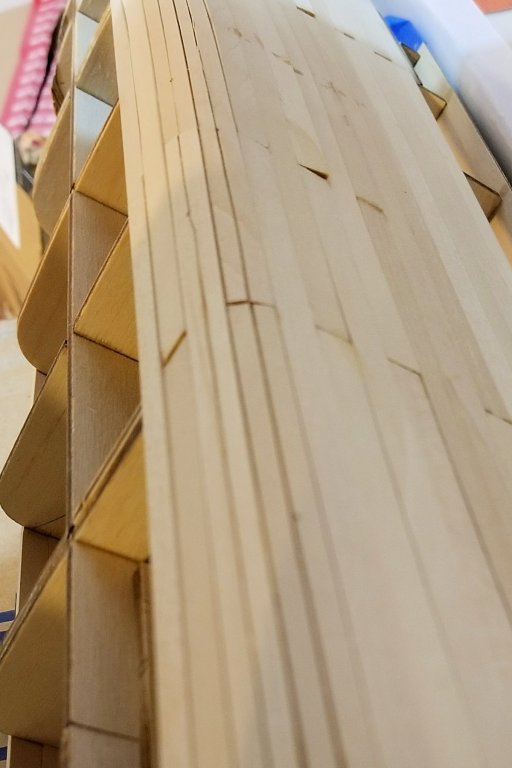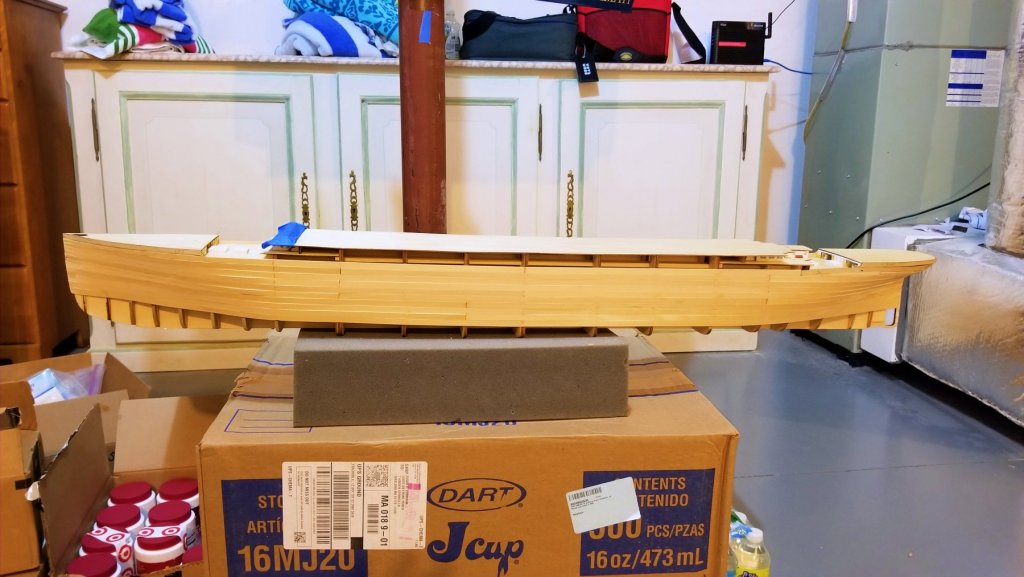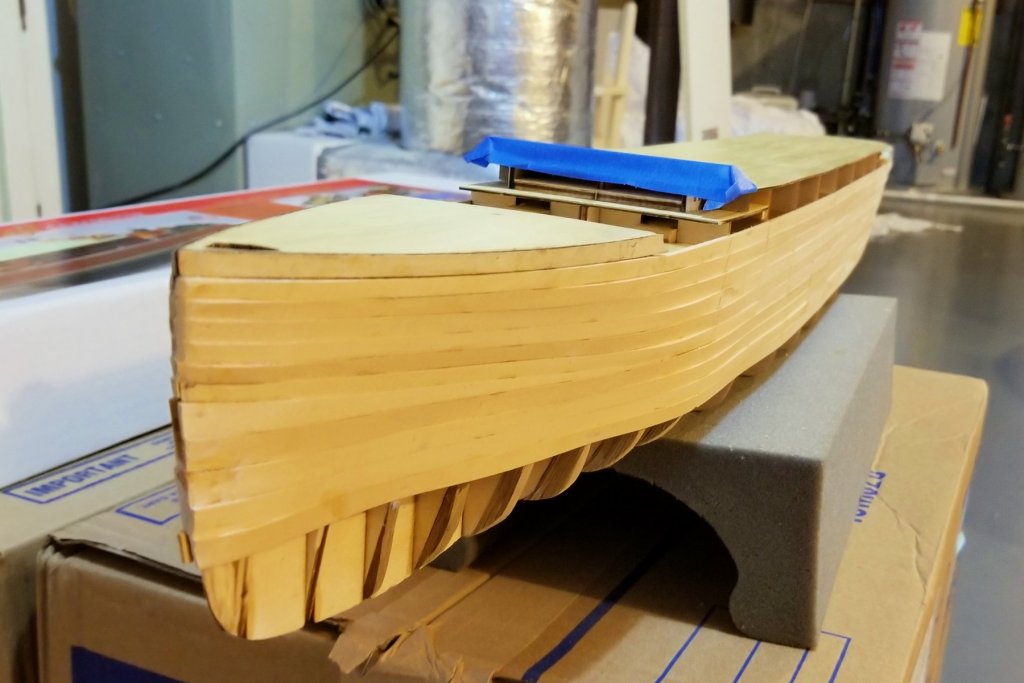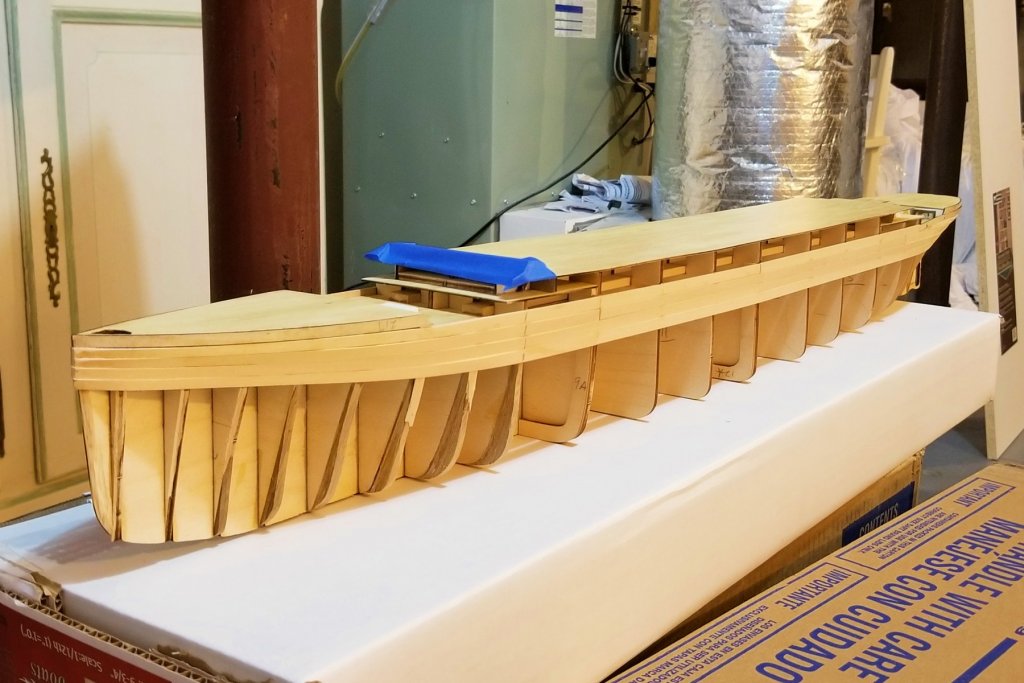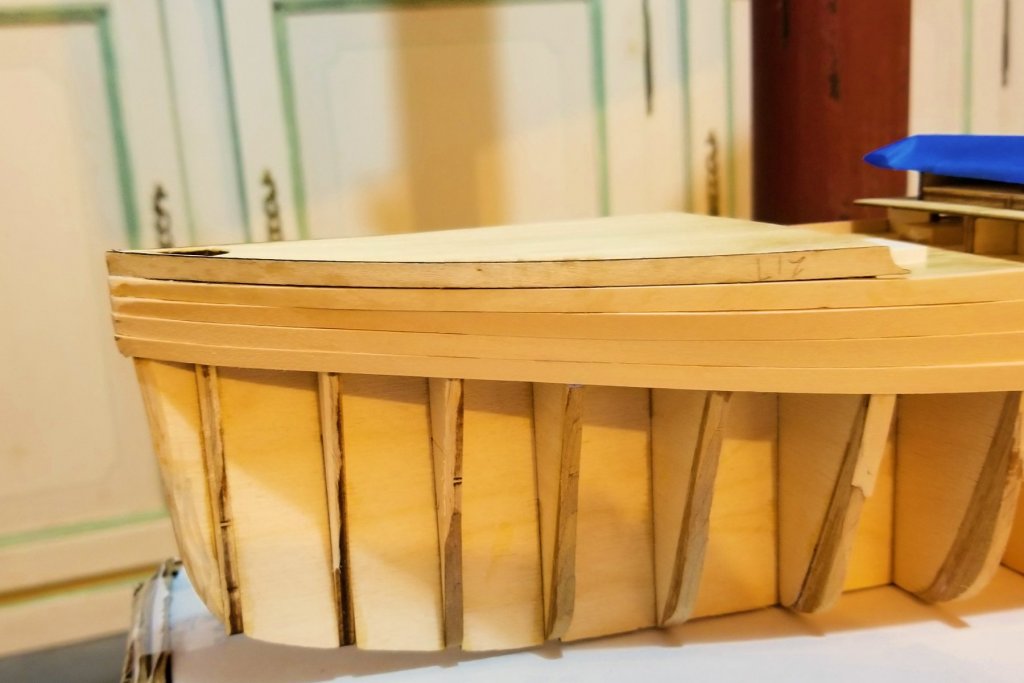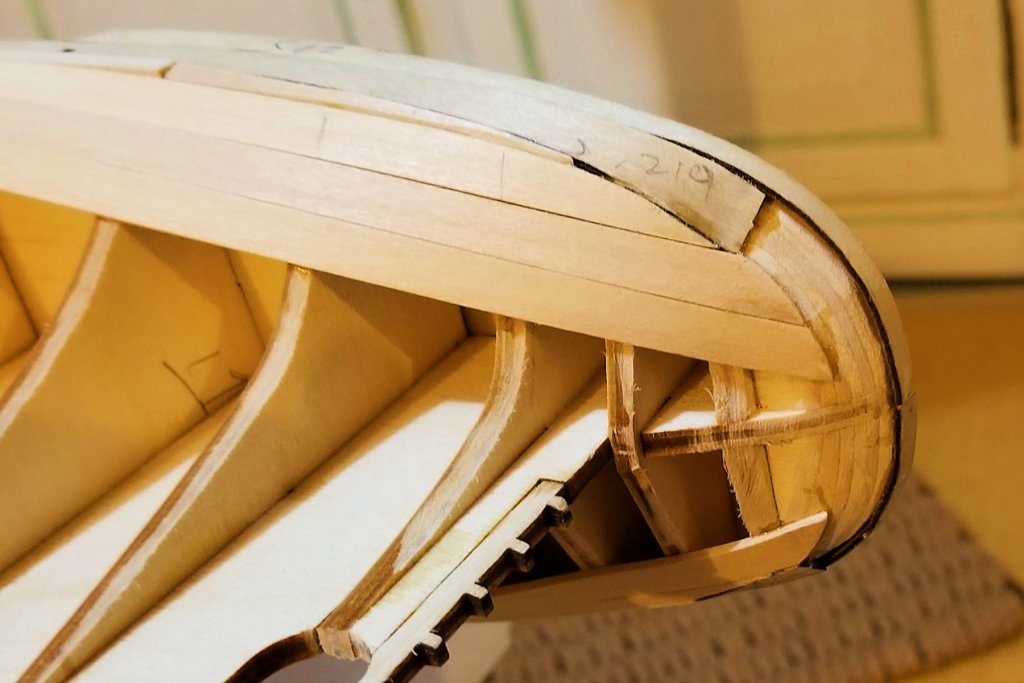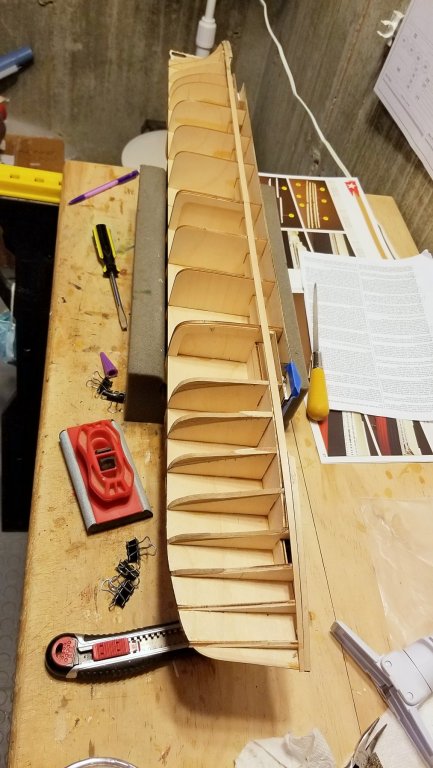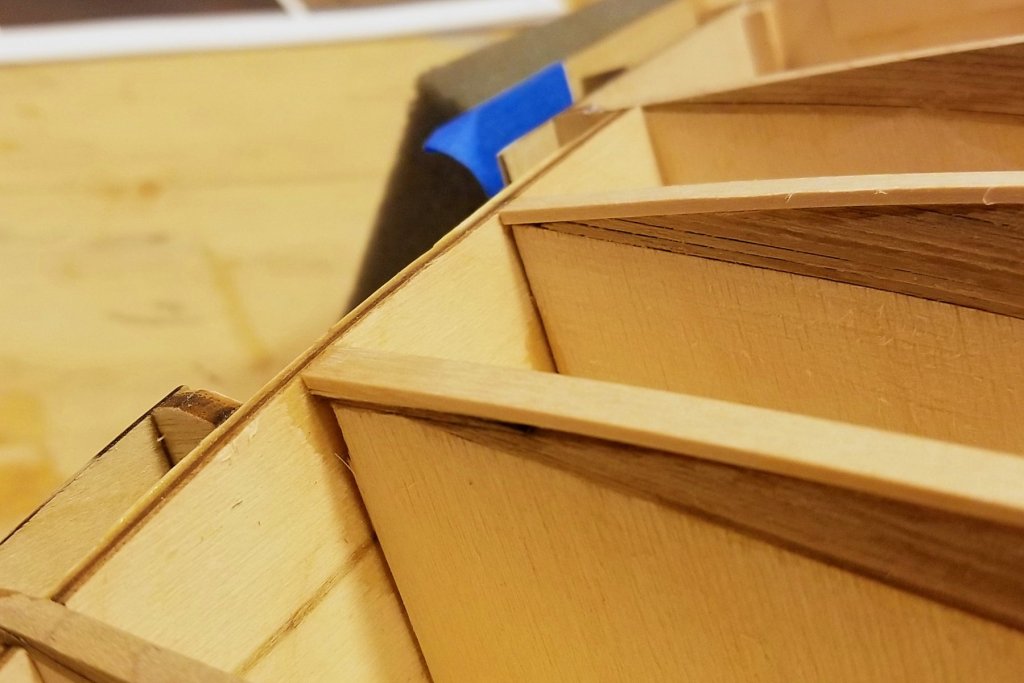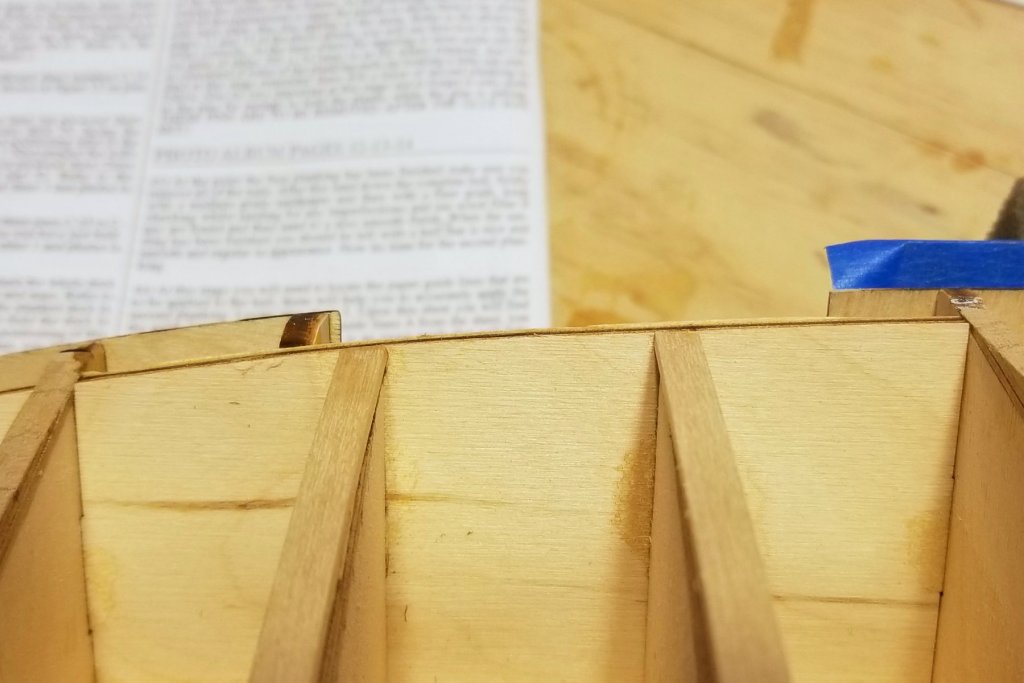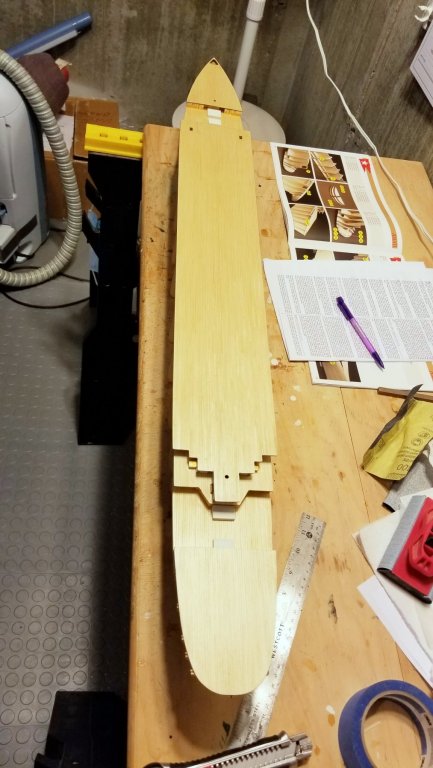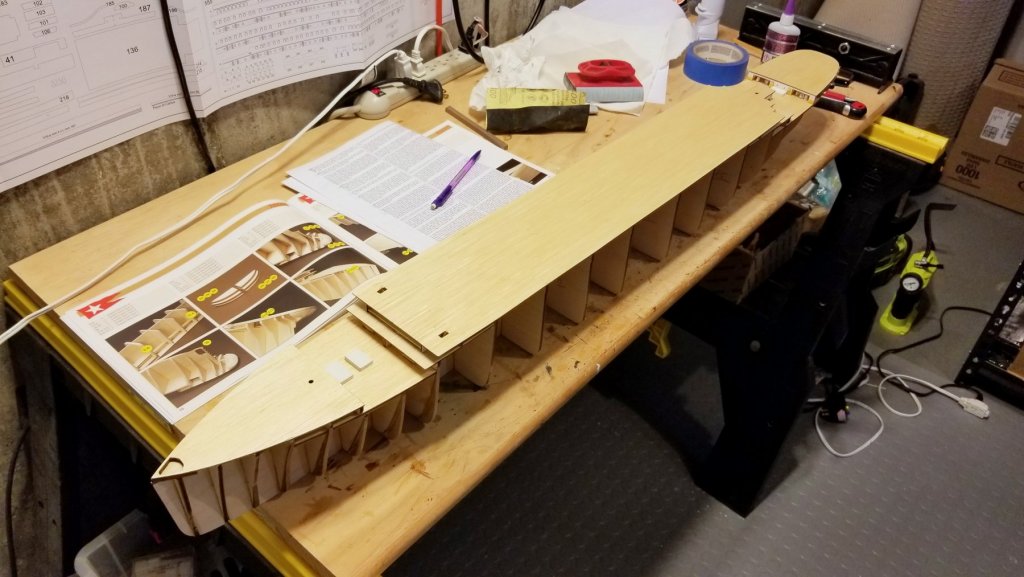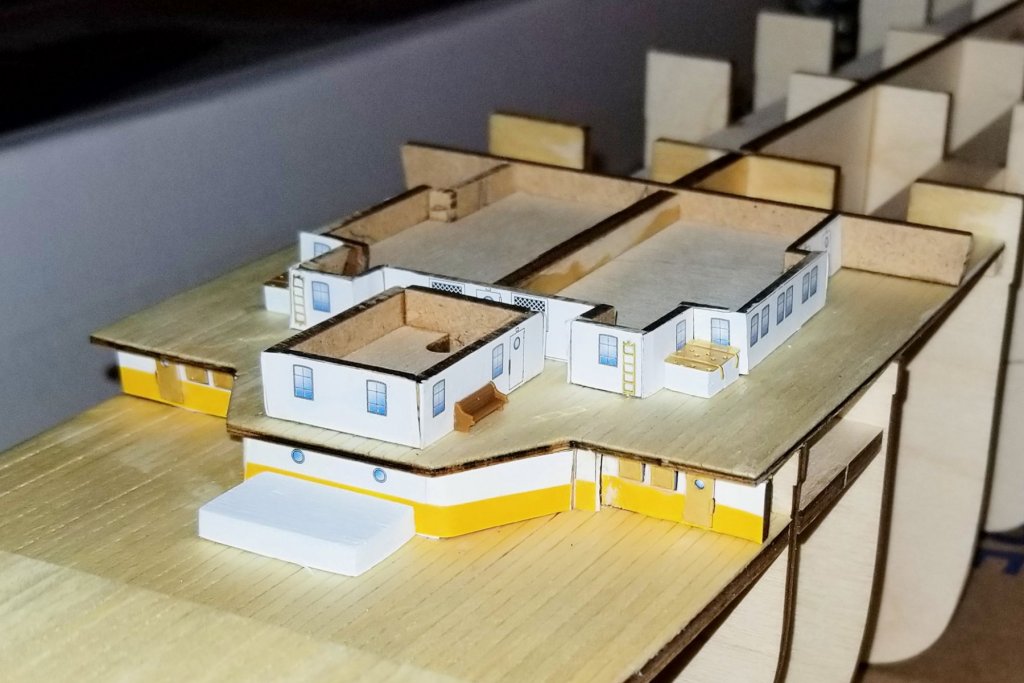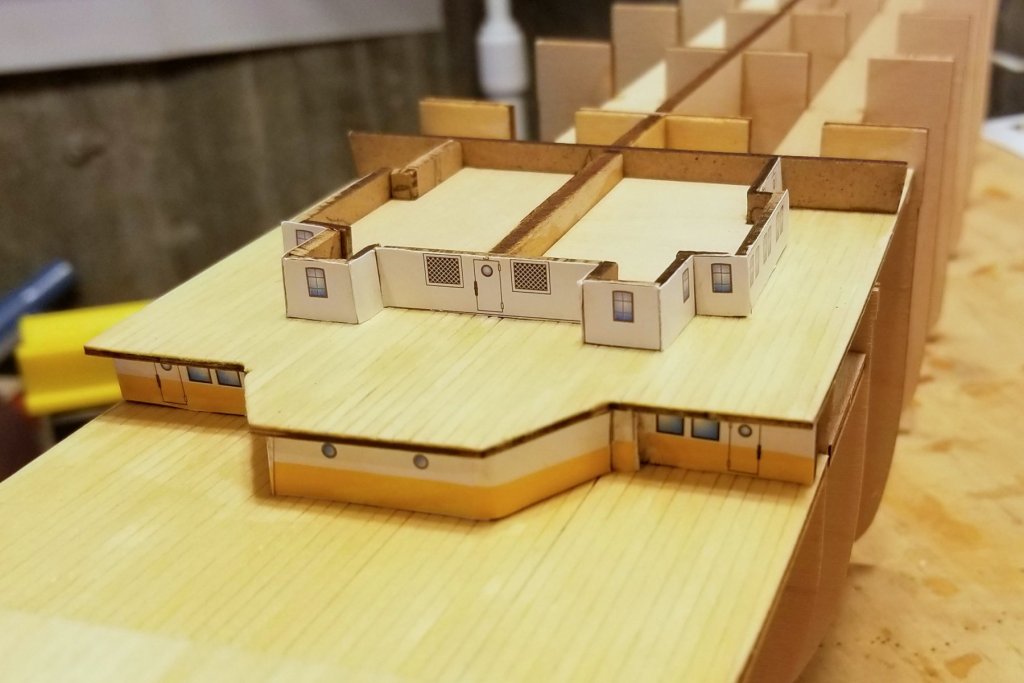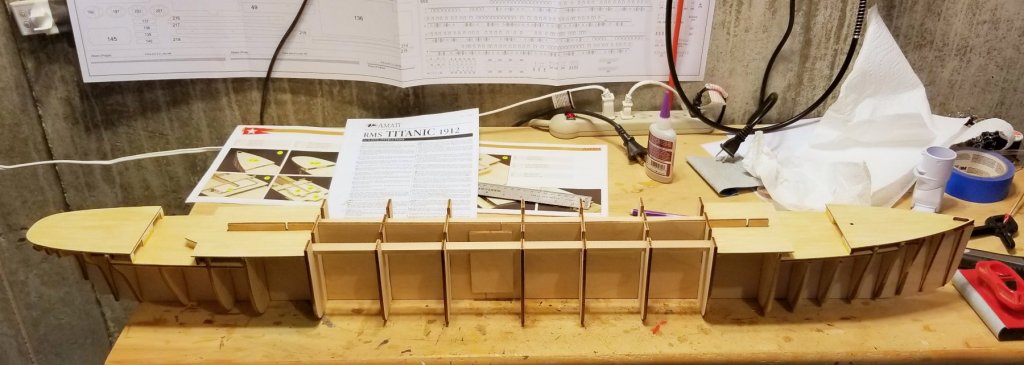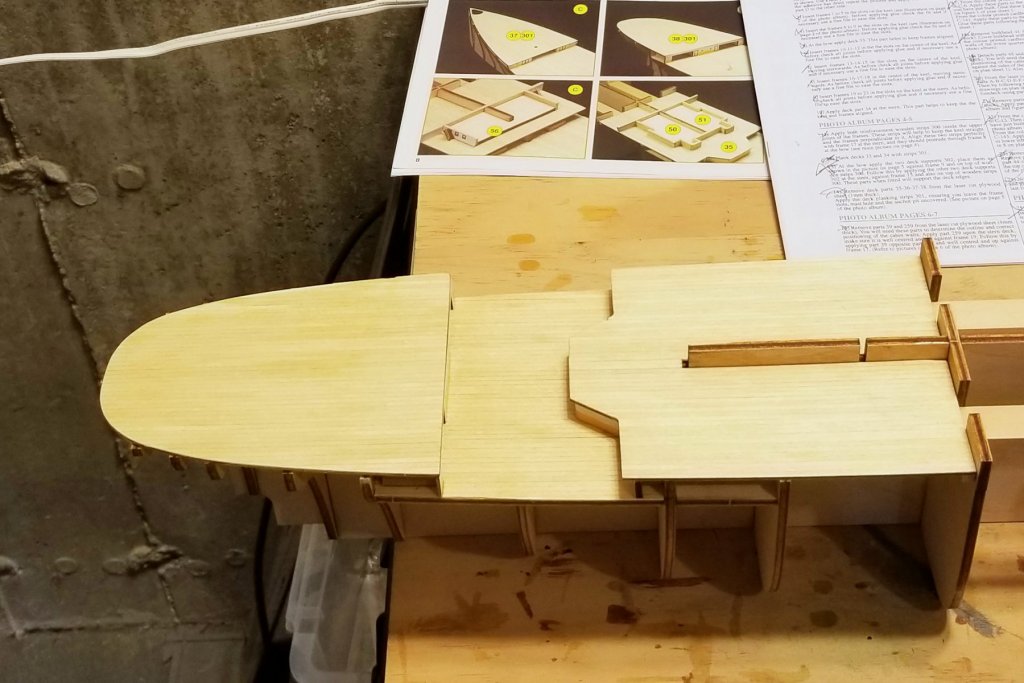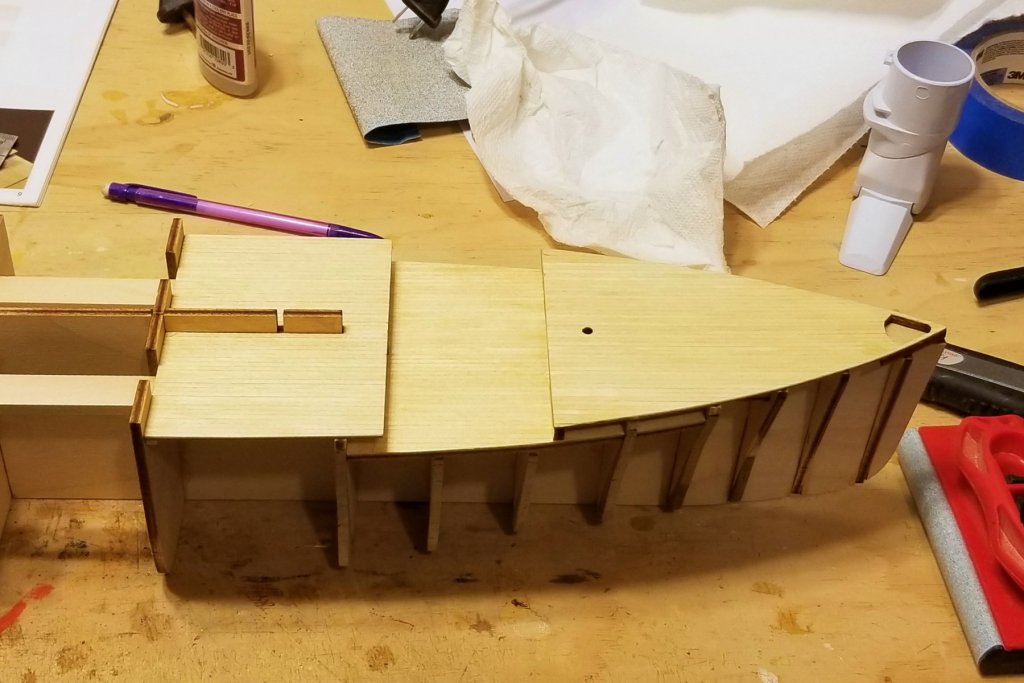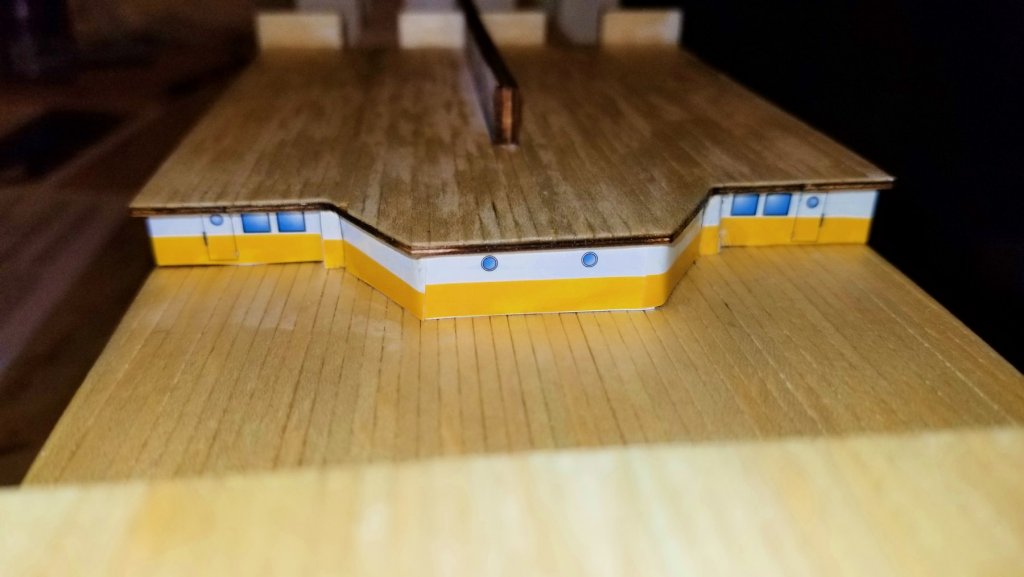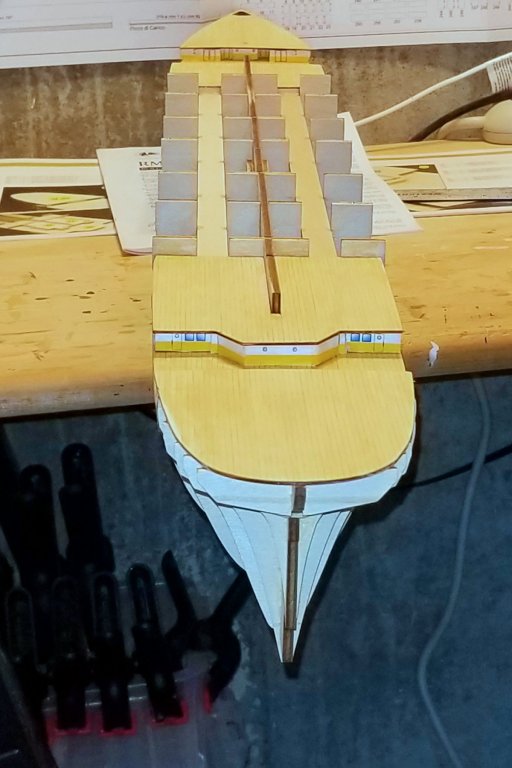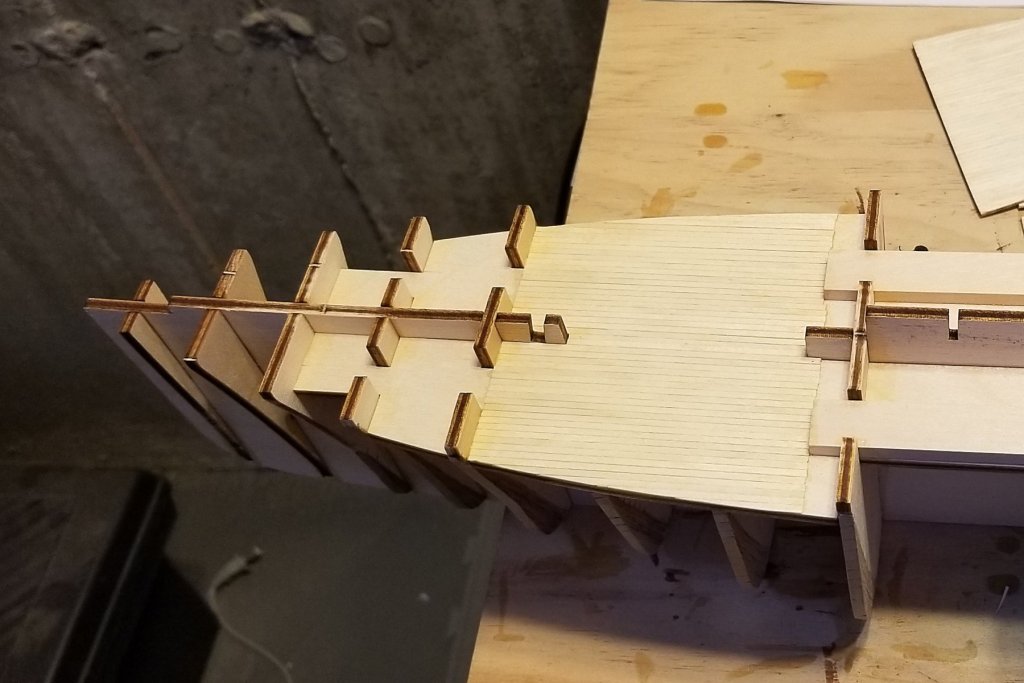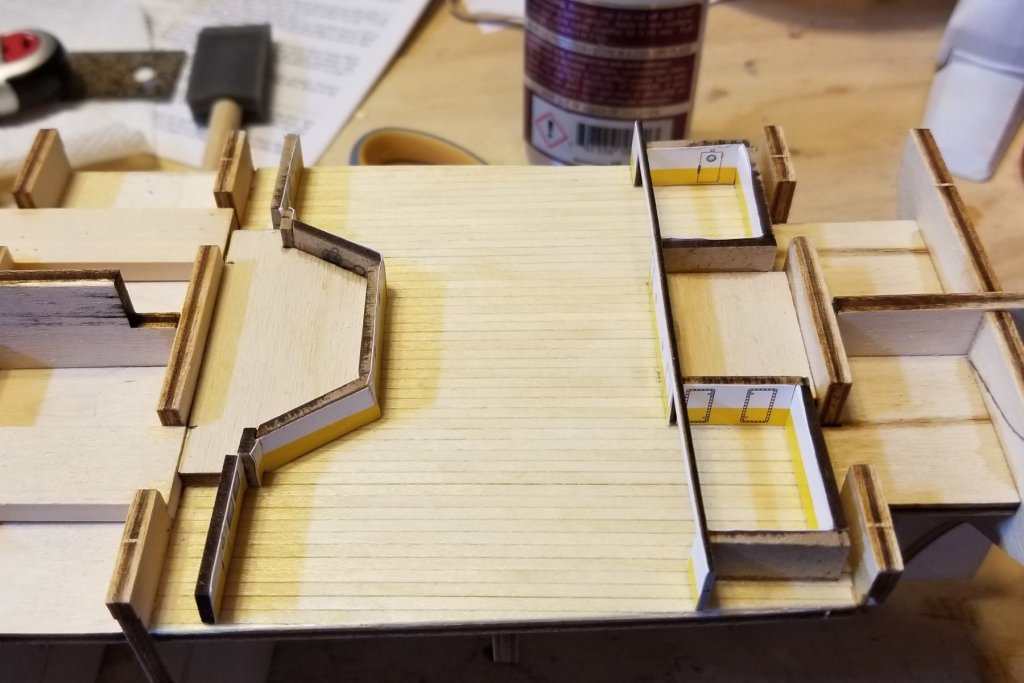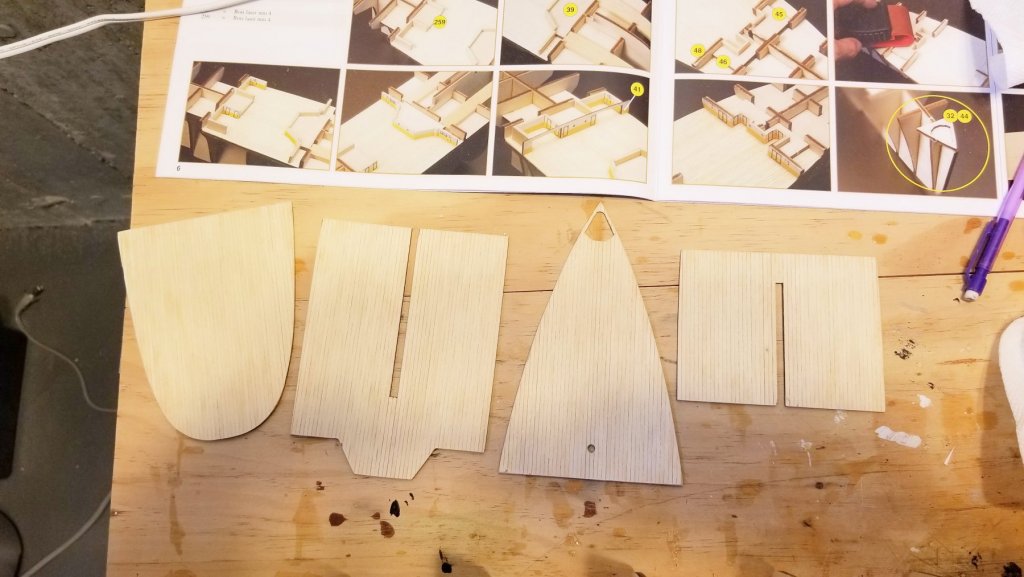-
Posts
1,071 -
Joined
-
Last visited
Content Type
Profiles
Forums
Gallery
Events
Everything posted by drobinson02199
-
Pic 1 shows the horizontal paper strips mounted on the thin plywood. I used spray adhesive. They are then cut out for mounting on the hull according to the guides pictured in my previous post. The instructions call for mounting the strips with pins only (there are about 18 on each side), then outlining them in pencil, then removing them to remove the vertical guides, then gluing them on again. I realized that the only reason for that two-step process is to get the vertical guides off the hull, and it occurred to me that I could just pencil mark their position, then remove them, and then mount the horizontal strips with glue in one step. Pics 2-4 show the marking process, and it should save me a bunch of time. I also hate pinning things as the pins come loose, or put holes in the wood that have to be filled, so this avoids that. Pic 5 is the first strip I've cut out. Strong sharp scissors work fine. I'll post again when I have some strips glued on. Regards, David
-
Ben: It's not a true second planking. It's horizontal hull-length strips of wood, with spaces in between. You can see the effect in the attached Amati picture. The pattern you see on the red colored hull runs all the way up to the top of the hull on the black part too. All of the pictures of the real Titanic are B&W, and the pattern isn't visible on the black hull (red is below the waterline). The strips have to be cut from a sheet of ply using paper patterns, which should be a real trip. Regards, David
-
Addendum: the other thing that happened is that I hit the end of the stern opening you can see and the rear half of the arc broke off. So I glued on a short piece of planking and then shaped it with my rotary tool sander, and it came out looking pretty good. All of which is to say that this step was full of pitfalls. Regards, David
-
First hull planking completed -- see picture. This was an interesting process with some "learning points" for me. I decided to buy a sheet sander -- and it really worked well getting the hull planks smooth. The problem was that it worked TOO well and some of the planks are now very thin. I think my mistake was using the same grit (120) for the electric sander that I had started to use with my sanding block. The electric sander is so efficient that a higher grit would have been better for the first sanding -- probably 180. Nevertheless, it came out pretty well overall, and with some help from wood filler and a coat of varnish, it's done. Now on to second planking. I'm going to have to be careful when I use pins to align the second planking to make sure I'm going into thick enough planks. Regards, David
-
The center of the Titanic's hull is tub-shaped, so the center frames make a sharp turn from the side to the bottom (Pic 1). The planks at 7mm wide would make bad wraparound on those frames (Pic 2). The obvious answer was to cut the planks lengthwise, but I was concerned that those cuts wouldn't be even (too long for my planking vise) and therefore wouldn't butt well. The solution was to split them partway with my knife (Pic 3) -- since only a part of one plank goes over the center frames, I could keep the rest unsplit. That meant that I could mount them with the split edges mated and get a good curve, as shown in Pic 4. Regards, David
-
Progress on first layer planking. For those of you who read the earlier posts on adjusting the shape of the bow frames: in the second pic, you will see how the shape of the bow is coming out. On the Amati pics of the model, the bow narrows sharply just where you see the blue tape on mine. As you can see, mine with the adjusted frames begins narrowing a bit further forward, and the narrowing slope is more even. Regards, David
-
Popeye: It does get a filler, later on. It consists of trapezoidal wedges of planking fitted into the semi-circle. I've been taking care to shape the ends to create a smooth circle so I won't need too much wood filler once the wedges are in. Regards, David
-
First layer hull planking started. So far this has gone pretty smoothly. At the stern, the planks need to be twisted with the steamer, but no side bending needed so far. I also had to put some stealers in at the stern just below the initial plank to align things between the laser cut sides and the initial plank, but they will sand/fill out. Regards, David
-
Initial bow and stern strips, and initial planking strip, in place. See pic below. I am posting this because I caught something at the last minute that the instructions aren't clear on, and that would have given me real problems later. The way the instructions read, you mount two stern laser cut strips first, and then butt the long planking strip up against the end of the second one. There are no instructions for alignment of the end of the second stern strip, so I just eyeballed the second one to look level with the horizontal hull structure. After I had glued almost all of the long strip, I began to worry about alignment with the deck above, so looked forward in the instructions, and sure enough, the distance is critical (16mm exactly from top of strip to bottom of deck), in order to fit a photo-etched piece in. What actually governs that distance is a set of very small notches in the frames, but they are easy to miss and I did. So I pulled up the long strip (fortunately the glue hadn't completely cured), and repositioned it exactly 16mm below, using the notches I could find after the rip-up, and a ruler for the rest. The way it should be done is to use a planking strip, dry-fitted under the notches, as the master guide, and align the stern strip end with that, and then finish out to the bow. I'll do that on the second side. There is no mention of the notches in the instructions, but they are obviously critical, so that's a big miss in the instructions. Regards, David
-
Getting ready for hull planking. In looking at how the frames align with the decks, I noticed that frames 6 & 7 fall short. If you look at the first pic, you'll see that the original frame is short -- not flush -- even after the laminated wood I added to bring the frames out. So I added some additional wood strip to bring these flush, which is what is required by the planking scheme. See pics. Regards, David
-
Chris: They are very narrow. As to length -- well, I have to confess that I didn't used fixed length planks on this one. I just ran the planking at full length, cut, ran the leftover the other way, butted in a new full length plank, and so forth. Simple reason -- a huge amount of this deck will end up being covered over. I'll likely slow down and do fixed length alternating planks on the upper decks. Regards, David
-
Another deck planked, mounted and varnished. Now the model turns over and a few structural pieces go on, and then the first layer of hull planking. Regards, David
-
Yes, the height to the top of the masts is 290mm. It's 215mm to the top of the stacks. Regards, David
-
I took another look at the plans and instructions, and after the step-by-step instructions finish with the first photo book (pp 1-31), they start to reference the plan sheets, and when they do, all of the fittings and deck structures come into play, including the PE doors and windows. So there may be a bit more organization: you have to reference the plan sheets to build the cabin structures and apply the printed decoration, but then reference them again for the fittings later on. It looks like leaving them to "later on" may work. Regards, David
-
Mr. Pucko: My first book has 32 pages (back cover of parts pictures is page 32). The second book has 8 pages of photos, including front and back cover, but the important ones are the inside 6, which are all views of deck fittings installed. If you can't find yours, I'd be happy to send you some hi res pics of my pages, since there aren't that many. Let me know. By the way, when I went to assemble the parts under the poop deck, I was going crazy trying to find cast metal ventilator housings, until I finally saw that the fan housing is made of wood (while the other parts are metal). Easy to miss if your eye is looking for metal. Regards, David
-
Here's a shout out to Mr. Pucko for his comment about getting PE parts and other detail onto the ship as I go. He's right -- the instructions don't mention it, and so I looked hard at the plan sheets, and saw that the parts are indicated there. What's deceptive is that the very good picture book doesn't show these things installed as the build progresses. It isn't until you get to the second book, which shows all the deck fittings at once, that they show up in the pics. And as Mr. Pucko suggests, at that point the installation would be much more difficult because of access restrictions. So here are two samples of what I went back and picked up. And now I'll study the plan charts carefully as I build, and look for details. Regards, David
-
Zappto -- Two layers, sort of. A base layer, followed by narrowly spaced strips. Regards, David
-
Another cabin structure built and decorated. I did this one differently. The manual says to build the structure, then cut out the pieces, and then glue them on. That leads to mis-fitted decoration pieces. So I used the cabin wall sections as templates to cut out the decoration pieces with a knife, then mounted the decorations to the loose wall pieces, and THEN built the walls. In the pic below you can still see imperfections, but to the naked eye it looks better than the one below it. Just takes a lot more forward planning. Regards, David
-
More progress with one more cabin wall done and all of the previously planked decks mounted. To address Chris's question: what you see is paper decoration glued onto the walls. Pic 4 shows it up close and you can see the imperfections at that distance. Pic 5 shows it at a more normal viewing distance. I would have preferred one continuous strip to mount so that there would be no seams between the pieces, which (at least for me) were unavoidable -- particularly on some very small pieces. But once the deck is mounted over the cabin walls, it looks fine (at a normal distance as I said). Re the decks: I'm clear coating them, which is the way they have it in the manual. Regards, David
-
First two decks planked and installed, and cabin structures built on the stern deck. Other decks also planked, awaiting installation. Regards, David
-
lgfrench -- I'll do it. I have always wondered why we don't see them posting in our model pages on this site, given how much feedback they could get. I wonder if they even follow their model builds. Regards, David
-
Chris -- If you look above in this thread, you'll see a post by lgfrench (who originally sent me the links on this) saying that he contacted Ages of Sail this past summer on this, and they contacted Amati and got nowhere. Ages of Sail is Amati's official distributor in the US. I don't think I've built a kit yet that didn't have some issue in the wood or the instructions. My HMS Fly had a serious lack of wood in some areas, which I was able to fix with my spare wood pile. On the other hand, the Revenge, a newer Amati kit, had tons more wood than was needed in all categories. I should admit that I'm paranoid about running out, so I really conserve wood as I go. Thanks, David
About us
Modelshipworld - Advancing Ship Modeling through Research
SSL Secured
Your security is important for us so this Website is SSL-Secured
NRG Mailing Address
Nautical Research Guild
237 South Lincoln Street
Westmont IL, 60559-1917
Model Ship World ® and the MSW logo are Registered Trademarks, and belong to the Nautical Research Guild (United States Patent and Trademark Office: No. 6,929,264 & No. 6,929,274, registered Dec. 20, 2022)
Helpful Links
About the NRG
If you enjoy building ship models that are historically accurate as well as beautiful, then The Nautical Research Guild (NRG) is just right for you.
The Guild is a non-profit educational organization whose mission is to “Advance Ship Modeling Through Research”. We provide support to our members in their efforts to raise the quality of their model ships.
The Nautical Research Guild has published our world-renowned quarterly magazine, The Nautical Research Journal, since 1955. The pages of the Journal are full of articles by accomplished ship modelers who show you how they create those exquisite details on their models, and by maritime historians who show you the correct details to build. The Journal is available in both print and digital editions. Go to the NRG web site (www.thenrg.org) to download a complimentary digital copy of the Journal. The NRG also publishes plan sets, books and compilations of back issues of the Journal and the former Ships in Scale and Model Ship Builder magazines.



